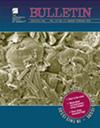Post-rift magmatism controlled by detachment faults in a microplate, northwestern South China Sea
IF 3.9
1区 地球科学
Q1 GEOSCIENCES, MULTIDISCIPLINARY
引用次数: 0
Abstract
Post-rift magmatism along continental margins is usually focused on highly stretched basins or aborted rifts. Adjacent microplates with relatively thick lithosphere are not expected to exhibit intense post-rift magmatism. This study identifies 20 mounded structures and associated pathways using two-dimensional, multichannel seismic data and ocean bottom seismometer (OBS) data across the southeastern Xisha Massif of the northwestern South China Sea. This massif is a relatively thick (>20 km) region of crust that forms a microplate between two rift branches. The mounded structures are interpreted as volcanoes, based on their seismic reflections and morphological characteristics. Detachment faults that extend into the middle crust captured the magma and provided pathways for vertical migration. During the rise of magma into the sedimentary stratum, detachment faults still served as the main channels of magmatic migration. The rigidity differences between the basement and the overlying sediments, as well as the stress field, facilitated subordinate pathways for magmatic migration, particularly at the depocenters and flanks of half-grabens. Consequently, larger volcanoes are present above the basement highs, while smaller volcanoes are located in the centers of half-grabens. This study provides criteria for identifying submarine mounded structures of different origins that are applicable beyond the study area. Moreover, this study highlights that detachment faults play a key role in the volcanic systems of the relatively rigid microplates of heterogeneous crustal structure. It also promotes our understanding of post-rift magmatism and the dynamic evolution of continental margins, and the results could be applicable to other areas with similar geological settings.南海西北部微板块中受拆离断层控制的裂谷后岩浆活动
沿大陆边缘的裂谷后岩浆活动通常集中在高度伸展的盆地或中止的裂谷上。岩石圈相对较厚的相邻微板块预计不会表现出强烈的裂谷后岩浆作用。本研究利用二维多通道地震数据和海底地震仪(OBS)数据,确定了南海西北部西沙地块东南部的20个隆起结构和相关路径。该地块是一个相对较厚(>20km)的地壳区域,在两个裂谷分支之间形成了一个微板块。根据其地震反射和形态特征,丘状结构被解释为火山。延伸到中地壳的分离断层捕获了岩浆,并为垂直迁移提供了途径。在岩浆上升到沉积层的过程中,拆离断层仍然是岩浆运移的主要通道。基底和上覆沉积物之间的刚度差异,以及应力场,促进了岩浆运移的次要途径,特别是在半地堑的沉积中心和侧翼。因此,较大的火山位于基底高点上方,而较小的火山位于半地堑的中心。本研究为识别不同来源的海底隆起结构提供了标准,适用于研究区域以外的区域。此外,这项研究强调,分离断层在非均质地壳结构的相对刚性微板块的火山系统中发挥着关键作用。这也促进了我们对裂谷后岩浆作用和大陆边缘动态演化的理解,其结果可适用于其他地质环境相似的地区。
本文章由计算机程序翻译,如有差异,请以英文原文为准。
求助全文
约1分钟内获得全文
求助全文
来源期刊

Geological Society of America Bulletin
地学-地球科学综合
CiteScore
9.30
自引率
8.20%
发文量
159
审稿时长
4-8 weeks
期刊介绍:
The GSA Bulletin is the Society''s premier scholarly journal, published continuously since 1890. Its first editor was William John (WJ) McGee, who was responsible for establishing much of its original style and format. Fully refereed, each bimonthly issue includes 16-20 papers focusing on the most definitive, timely, and classic-style research in all earth-science disciplines. The Bulletin welcomes most contributions that are data-rich, mature studies of broad interest (i.e., of interest to more than one sub-discipline of earth science) and of lasting, archival quality. These include (but are not limited to) studies related to tectonics, structural geology, geochemistry, geophysics, hydrogeology, marine geology, paleoclimatology, planetary geology, quaternary geology/geomorphology, sedimentary geology, stratigraphy, and volcanology. The journal is committed to further developing both the scope of its content and its international profile so that it publishes the most current earth science research that will be of wide interest to geoscientists.
 求助内容:
求助内容: 应助结果提醒方式:
应助结果提醒方式:


